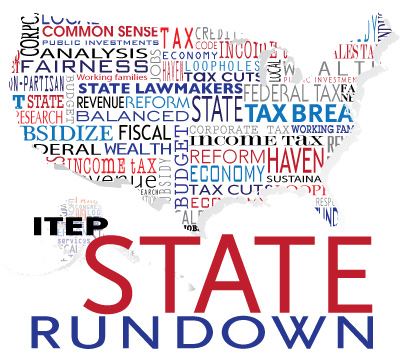INTRODUCTION
The trend is clear: states are experiencing a rapid decline in state corporate income tax revenue. Despite rebounding and even booming bottom lines for many corporations, this downward trend has become increasingly apparent in recent years. Since our last analysis of these data, in 2014, the state effective corporate tax rate paid by profitable Fortune 500 corporations has declined, dropping from 3.1 percent to 2.9 percent of their U.S. profits. A number of factors are driving this decline, including: a race to the bottom by states providing significant "incentives" for specific companies to relocate or stay put; blatant manipulation of loopholes in state tax systems by corporate accountants; significant cuts in state corporate tax rates; and the erosion of state corporate tax bases, largely due to ill-advised state-level linkages to the federal system.
How is this playing out in the states? Indiana offers one illustration. In 2011, state lawmakers enacted a significant across-the-board tax cut for corporations, which is still being phased-in and will eventually slash the state's effective tax rate from 8.5 to 4.9 percent. But even with this cut on the way, the Carrier Corporation announced in February of 2016 that it was going to move 2,100 jobs from Indiana to Mexico. Later the same year, in a move that made national headlines, the "Carrier Deal" was struck by incoming President Trump and Indiana Governor Mike Pence, keeping 1,000 jobs in the state in exchange for a package of state and local tax incentives. Oddly enough, however, those incentives were dwarfed in size by the cost savings the company stood to receive from making the move to Mexico. There has since been speculation that tax considerations
were inconsequential to the company's decision-making process and that Carrier, whose parent company depends heavily on taxpayer-funded federal contracts for its business, simply wished to remain in the good
graces of the Trump Administration. Nonetheless, Carrier accepted both the incentives and the rate cuts while the state's revenue collections for vital programs suffered as a result.
This report is the third in a series of comprehensive studies that look at the taxes paid by the most consistently profitable Fortune 500 corporations (over the eight-year period from 2008 to 2015). In March of 2017, we released The 35 Percent Corporate Tax Myth, showing that many Fortune 500 corporations have been able to sharply reduce their federal income tax bills, often reducing them to zero-or less-in years when they were quite profitable. Here, we take a hard look at what many of these same corporations paid over that eight-year span in state income taxes nationwide.
Of the 258 profitable Fortune 500 corporations included in our federal study, 240 fully disclosed their state and local income tax payments.
Here are some of the key facts that these companies' annual reports reveal:
* Between 2008 and 2015, these 240 companies paid state income taxes equal to less than 2.9 percent of their U.S. profits. Since the average statutory state corporate tax rate is about 6.25 percent (weighted by gross state product), that means that over this period, more than half of their profits escaped state taxes entirely.
* If these 240 corporations had paid the 6.25 percent average state corporate tax rate on the $3.7 trillion in U.S. profits that they reported to their shareholders, they would have paid $231.8 billion in state corporate income taxes over the 2008-15 period. Instead, they paid only $105.8 billion. Thus, these 240 companies avoided a total of $126 billion in state corporate income taxes over the eight years.
* 92 of the 240 companies managed to pay no state income tax at all in at least one year from 2008 through 2015, despite telling their shareholders they made $348 billion in pretax U.S. profits in those no-tax years. Forty-nine of these companies enjoyed multiple no-tax years.
* Nine companies, including Dupont, International Paper, and Facebook, paid no net state income tax in at least four years during this eight-year period.
* And four companies, Pepco Holdings, International Paper, Levi Strauss and Ameren, managed to pay zero or less in state income tax during the eight-year period taken as a whole.
* In 2015 alone, 24 companies paid no state income tax. Another 131 of the companies paid less than half the weighted-average statutory state corporate tax rate that year, meaning that more than half of the companies in our sample paid less than half the average legal state tax rate in that year. This report comes at a time when lawmakers in a number of states (including Louisiana, Oklahoma, and West Virginia) have considered outright repeal of their state corporate income taxes, and when several other states (including Arizona, Illinois, Indiana, Mississippi, New Mexico, North Carolina, and the District of Columbia) have moved to cut their corporate tax rates. In a continued "race to the bottom" in corporate tax policy, many states are also moving toward a "single sales factor"-more on this below.
But the report's findings suggest that the first step in true corporate tax reform should be ensuring that the very biggest and most profitable corporations are paying something resembling the legal tax rate. When these large companies are able to dodge state income taxes on their U.S. profits, the inevitable impact is a tax shift away from big corporations and onto everyone else, including small businesses and middle-income families. Creating a level playing field between large businesses and "mom and pop" businesses should be a priority for state policymakers-but that is best done by repealing harmful tax giveaways, not by repealing the corporate tax outright.
Note on interpreting the findings of this report
The companies in our survey typically operate all over the country. But they don't disclose their profits and taxes on a state-by-state basis-so the findings of this report don't tell us conclusively whether individual companies paid any income tax in specific states. Instead, what we know is how much these companies have paid to all states in which they do business. The tables at the end of this report sort the tax data for all 240 companies not only alphabetically and by tax rates, but also by the location of each company's headquarters. On the pages that follow, we give details about the 92 firms that paid no state income tax in at least one year
from 2008 through 2015.
THE LONG-TERM DECLINE OF STATE CORPORATE INCOME TAXES
Few state tax trends are as striking as the rapid decline of state corporate income tax revenues. As recently as 1986, state corporate income taxes equaled 0.5 percent of nationwide Gross State Product (GSP) (a measure of statewide economic activity). But in fiscal year 2013 (the last year for which data are available), state and local corporate income taxes were just 0.33 percent of nationwide GSP-representing a decline of over 30 percent. Even more worrisome is that as corporate profits have rebounded (and boomed) in recent years, state and local corporate taxes have not kept pace: corporate taxes as a share of nationwide corporate profits remain near the lowest point in the past quarter century. This long-term decline in the state corporate income tax has three broad causes: the trickle-down impact of federal corporate tax cuts, ill-advised tax "incentives" intentionally enacted by state lawmakers, and unintended tax shelters created by companies armed with creative accounting staffs.
. . .
CONCLUSION
The data in this report show in stark terms just how successful large, multistate and multinational corporations have become at shirking their tax responsibilities to state and local governments. They have been abetted in this effort by America's major accounting firms, have used heavy lobbying and even threats to extract further tax breaks, and have often persuaded state elected officials to become their facilitators. As a result, individual taxpayers and purely in-state (usually smaller) businesses are paying a heavy price, in the form of higher taxes, reduced public services and unfair competition.
But the report is as notable for what it does not tell us-and for what state policymakers are simply not equipped to know-about how businesses in each state are paying taxes.
State taxpayers can continue to tolerate this situation, or they can call on their elected representatives to take steps to address it. This report outlines some pathways to state corporate tax reform. If adopted, they would help restore state corporate income taxes to the progressive-and popular-way to pay for needed state programs.



